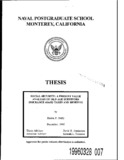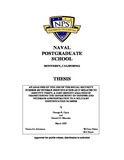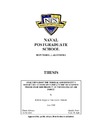The social discount rate: some implications of the budget-constrained opportunity cost approach

Download
Author
Ng, Kok Chuan
Date
1991-03Advisor
Boger, Dan C.
Terasawa, Katsuaki L.
Second Reader
Hughes, Wayne P. Jr.
Metadata
Show full item recordAbstract
The social discount rate is an important issue in the cost-benefit analysis for selecting public projects. However, there has been no general consensus as to the appropriate value of the social rate of discount for public investment. In 1987, Quirk and Terasawa proposed using the opportunity cost rate of return as an alternative approach to the choosing of the social discount rate in a fixed-budget scenario. Essentially, the appropriate value of the government rate of discount is the highest rate of return available from the portfolio of the unfunded government projects. In this study, the characteristics of the discount rates is explored in the context of choosing an efficient portfolio of government projects under a fixed budget condition. The costs and benefits of the projects are treated as variables and are to be endogenously determined by optimizing the overall discounted benefits. It is assumed that the costs and benefits of projects are known and continuous functions of force size, unit system maintenance and operational support. A mathematical model is used to represent the relationship between the benefit and cost of various projects. The Karesh-Kuhn-Tucker (KKT) convexity conditions are assumed for these so-called diminishing-return projects. In addition, two-year constant-returns-to-scale projects with fixed rates of return are introduced as reference projects such that their rates of return can be used directly as the discount rates under the concept of the opportunity cost rate of return. The discounted present values (DPV) of the net benefits of both the optimal and the non-optimal portfolios are found to be in agreement with those expected under the concept of the opportunity cost rate of return.
Rights
Copyright is reserved by the copyright ownerCollections
Related items
Showing items related by title, author, creator and subject.
-
Social Security: a present value analysis of Old Age Survivors Insurance (OASI) taxes and benefits
Duffy, Shawn P. (Monterey, California. Naval Postgraduate School, 1995-12);This thesis presents a present value analysis of the Old-Age Survivors Insurance (OASI) comparing retirement benefits under Social Security with alternative private sector plans and provides a spreadsheet model for ... -
An analysis of the use of the Social Security Number as Veteran Identification as it relates to identity theft : a cost benefit analysis of transitioning the Department of Defense and Veterans Administration to a Military Identification Number
Maraska, Donald G. (Monterey, California. Naval Postgraduate School, 2007-03);Identity theft has become one of the fastest growing crimes in America and stems from the widespread and growing reliance of organizations across the nation to use Social Security Numbers (SSN) as a primary personal ... -
ANALYZING HOW THE FEDERAL GOVERNMENT’S BUDGETARY CONSTRAINTS IMPACT THE HELICOPTER PROGRAM (H-XBR PROJECT) IN THE BRAZILIAN AIR FORCE
do Nascimento Pinheiro, Roberto Sergio (Monterey, CA; Naval Postgraduate School, 2019-06);The purpose of this project is to analyze how the federal government’s budgetary constraints, which impose limitations on the commitment and payment of budget appropriations, have influenced the creation of value and ...


 socialdiscountra00ngko.pdf (2.960Mb)
socialdiscountra00ngko.pdf (2.960Mb)

